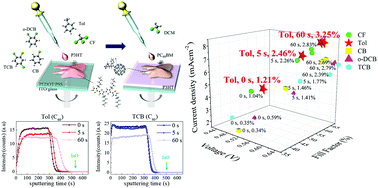Manipulating the crystal structure of a conjugated polymer for efficient sequentially processed organic solar cells†
Abstract
Recently, the sequential (Sq) process, which forms nanoscale network structures from quasi-solid-state inter-diffusion through swelling and annealing, is considered to be one of the most efficient methods for fabricating organic solar cells and blend films. Here, we examined the effect of the crystallinity and orientation of poly(3-hexylthiophene) (P3HT) molecules on the formation of the nanostructure by carrying out a Sq process using various solvents with different boiling points. We showed that the moderate crystallinity promoted suitable inter-diffusion between the donor (P3HT) and acceptor ([6,6]-pentadeuterophenyl C61 butyric acid methyl ester, PC60BM), and hence was important for achieving high-performance solar cells using Sq processing. Nanostructure formation by inter-diffusion was investigated and visualized by taking a combination of grazing-incidence wide-angle X-ray scattering (GIWAXS) and time-of-flight secondary ion mass spectrometry (ToF-SIMS) measurements. In addition, our Sq-processed solar cell yielded a device efficiency as high as 3.25%, and was also impressive because it was made with an eco-friendly solvent and using a short-duration annealing process, in contrast to the conventional BHJ process. The present findings provided advanced insight into the Sq process, and we anticipate this efficacious sequential process to contribute not only to the development of higher-efficiency organic solar cells but also to the fabrication of functional blend films.



 Please wait while we load your content...
Please wait while we load your content...